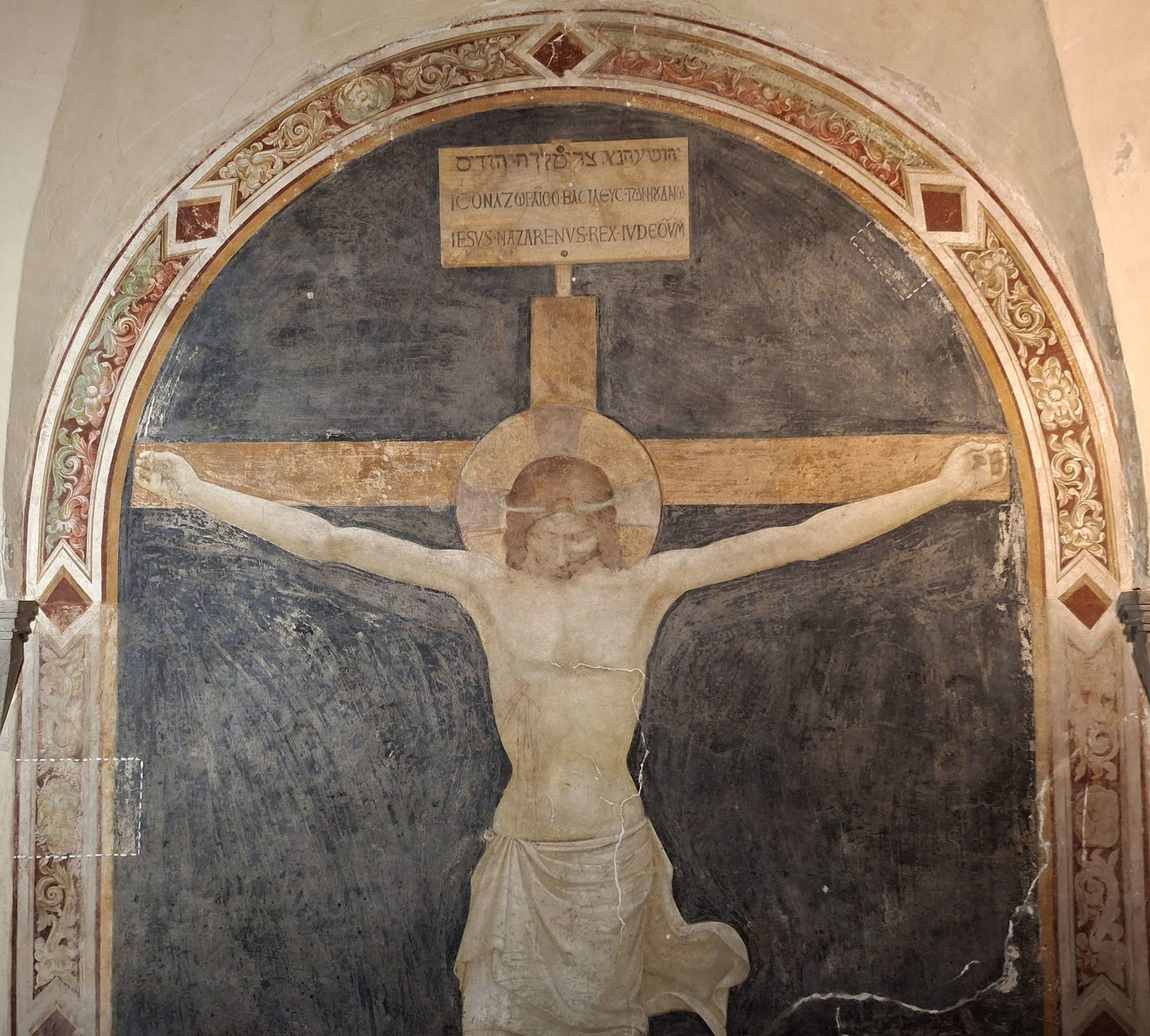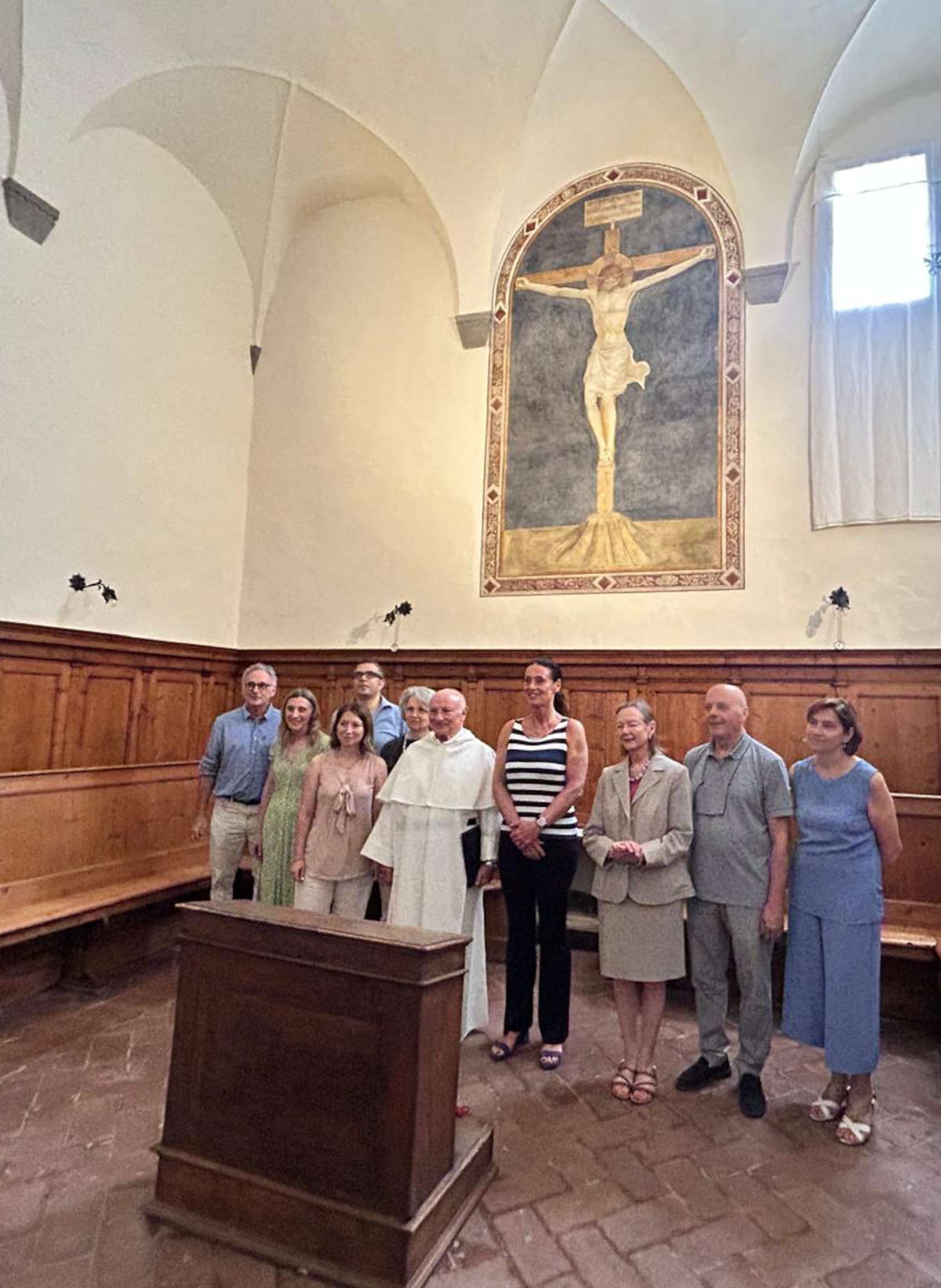After a long and delicate conservation operation, Beato Angelico ’s Crucifixion is finally back on view in the Convent of San Domenico in Fiesole (Florence). The work, of extraordinary artistic and spiritual importance, underwent a maintenance restoration made possible thanks to the support of the Friends of Florence Foundation. The work was carried out by restorers Cristiana Conti and Alessandra Popple, of the company SAR snc, under the high supervision of the Soprintendenza Archeologia, Belle Arti e Paesaggio for the Metropolitan City of Florence and the provinces of Pistoia and Prato.
The fresco, located in the Chapter House of the ancient convent, was known to few, hidden for centuries and rediscovered only in the late 19th century. Its re-emergence and recent restoration return to the community a youthful but intense work by the Florentine master, painted in the first half of the 15th century and already witnessing the unmistakable spirituality that would mark his entire output.
“Friends of Florence’s commitment to the works of Beato Angelico continues with this project for the beautiful Crucifixion in the Sala del Capitolo of San Domenico,” stresses Simonetta Brandolini d’Adda, president of Friends of Florence. “In front of the fresco, within the walls of the convent in the Chapter House, the serenity and spirituality that the work conveys to us is part of a truly moving experience. We thank the Fathers who opened the doors of the Convent of San Domenico allowing us to work, the officials of the ABAP Superintendency who, with attention, followed the work, the generous donor Gerhard De Geer together with the enlightened doctors of the Belacqua group (Camilla Alderighi, Raffaele Rasoini and Steven Woloshin). We are also grateful to Cristiana Conti and Alessandra Popple for the excellent restoration performed.”

The fresco depicts the Crucifixion of Christ with an essential and meditative composition in keeping with Beato Angelico’s painting. The cross stands out against a stylized Golgotha and a dark blue, almost black background, originally intended for the dry application of azurite, a pigment that, however, does not turn out to have been used. Christ’s posture is striking, with his head recumbent downward in a perspective rendering unusual for the artist, also found in a cell in St. Mark’s Convent but now badly deteriorated.
The frame decorated with plant and quadrangular motifs frames the fresco, which is completed by a cartouche bearing, in Greek, Latin and Hebrew, the words “Jesus Nazarene King of the Jews,” the same as the fresco in the former Chapter of St. Mark’s. The work was most likely concealed in 1566, when the entire wall of the chapter house was whitewashed, as reported in a 19th-century chronicle of the convent. It was rediscovered only in 1880 by Father Raimondo Magrini, and was followed by a first restoration in 1881, during which the face of Christ and the frame, then in serious condition, were retouched.

After the nineteenth-century restoration, two more interventions were carried out by Dino Dini: the first in 1955, the second in 1984, when the expert restorer applied barium hydroxide to the surface-a technique that was innovative at the time-and made new pictorial retouches. Since then, the work has not undergone restoration, leaving obvious signs of degradation and chromatic alterations to emerge over time, particularly in the figure of Christ, where the pictorial material had almost completely disappeared.
The latest conservation campaign, which has just been completed, also proved crucial for the technical study of the work. It was discovered, for example, that the fresco was executed in nine days of work, with the use of shell gilding - such as that of the halo - and the use of mixed techniques such as sanguine drawing and dusting. Traces of pencil traces also emerged that can be traced to nineteenth-century remakes, clear signs of the various conservation phases to which the work was subjected.


The state of conservation prior to the intervention was definable as “intermediate” according to the restorers’ assessment, but with some significant criticalities. The entire pictorial surface was compromised by dust deposits and a thick layer of black smoke, probably due to the heating of the environment. The most affected area was precisely the face of Christ, where the gaps and loss of morphological details were evident, also aided by inaccuracies in the 19th-century descialbo that had inaccurately removed the lime with which the fresco had been covered.
During the cleaning operations, the presence of hammering - a sign of manual intervention to detach the descialbo - and of small residual portions of the same, confirming the practice of concealment undergone by the work in past centuries, was revealed. Other damage was visible along the cracks in the plaster, in the edges of the execution days and in the decorative frame, which showed abrasions, chromatic losses and remakes.
The once uniform dark blue background was altered by patches of moisture that had impaired its visual reading. The lower part of the fresco, particularly the Golgotha and the lower portion of the cross, was largely repainted, probably due to seepage from outside.

Thanks to the solicitation of some frequenters of the church of San Domenico, the decisive contribution of Gerhard De Geer and the support of the Belacqua Group - composed of Camilla Alderighi, Raffaele Rasoini and Steven Woloshin - the initiative was accepted by the Friends of Florence Foundation, which fully financed the restoration.
A virtuous example of collaboration between private individuals, religious bodies and public institutions, which allowed not only the conservation of the work, but also its enhancement and return to the community. Present at the presentation of the restored fresco were, among others, the Prior of the Dominican community Father Giovanni Monti, the mayor of Fiesole Cristina Scaletti, the president of Friends of Florence Simonetta Brandolini d’Adda, and art historians Angelo Tartuferi and Carl Brandon Strehlke.
The restoration of Beato Angelico’s Crucifixion is part of a broader reflection on the need to safeguard the lesser-known artistic heritage, often hidden in convents or cloistered environments, yet of the highest cultural value. The case of the Fiesole fresco shows how conservation intervention is not only a technical matter, but also a work of rediscovery and restitution of memory.
The possibility, today, to admire again the fresco - for a long time unknown even to many scholars - represents an enrichment not only for the local religious community, but for all those who recognize in the art of Beato Angelico an absolute summit of the figurative spirituality of the Renaissance. A work that, in its silent essentiality and troubled history, once again tells of the profound value of beauty as a common good.
 |
| Fiesole, Beato Angelico's Crucifixion returns to view after major restoration |
Warning: the translation into English of the original Italian article was created using automatic tools. We undertake to review all articles, but we do not guarantee the total absence of inaccuracies in the translation due to the program. You can find the original by clicking on the ITA button. If you find any mistake,please contact us.